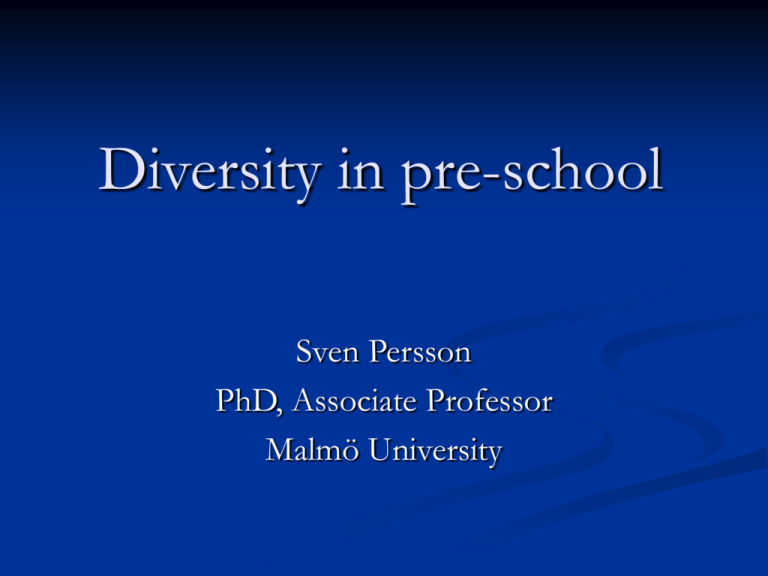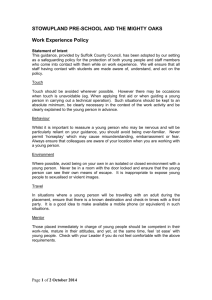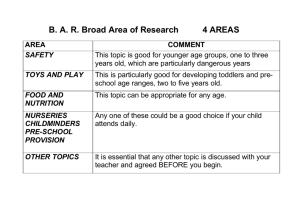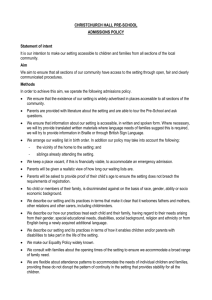Is preschool an institution for normalization and “Swedishness”?
advertisement

Diversity in pre-school Sven Persson PhD, Associate Professor Malmö University CV Research Overview: Conditions for learning in preschool and pre-school classes (Swedish Research Council). Pre-school from a societal perspective. Thesis: Parent’s images of children and child care. Research Co-ordinator, Centre for Diversity in Education. Research on relational pedagogy in Centre for Professional Studies. Teacher Education, supervision of doctoral students. Pre-school teacher. Centre for Diversity in Education A Venue for Research and School Improvement City of Malmö Centre for Diversity in Education The National Agency for School Improvement Malmö University Thematic Weeks (ex Diversity Week) Support for Development Projects Competence Development free of charge Local Commissions Research Education for Pedagogues National Commissions Centre for Research Study Groups Networks 6 Welcome to Malmö – meetings and possibilities Photo:X-RAY FOTO/Leif Johansson • Malmö is the growth centre of the region • 277,000 inhabitants • Population expanding for the twenty-second year in a row • 26% of the city’s inhabitants were born abroad • 169 nationalities represented • Young population: 47% are under 35 years of age 7 Diversity - Meetings - Possibilities Photo:X-RAY FOTO/Leif Johansson Photo: X-RAY FOTO/Leif Johansson 8 Diversity – key to the future of Malmö • 70,600 of the city’s inhabitants were born abroad • There are 169 different nationalities in Malmö • This multi-cultural society creates opportunities for Malmö to assert itself in an increasingly globalised economy • Diversity creates conditions for a rich cultural life • Around 147 different languages are spoken in Malmö, not including the Nordic languages Pre-school Pre-school: 1-5 years Pre-school classes: 6 years Compulsory school: 7 years Children’s attendance in pre-school 50 % of one-year-old children 87 % of two-year-old children 96 % of five-year-old children Curriculum for pre-school Children should be aware of their own cultural heritage and participating in the culture of others. Children with a foreign background who develop their first language should improve their prospects of learning Swedish as well as developing knowledge in other areas. Multi-cultural identity Pre-school should help to ensure that children from national minorities and children with a foreign background receive support in developing a multi-cultural identity. Support for children’s mother tongue language in pre-school Mother tongue teachers in 13 different languages are supporting immigrant children in pre-school. Individual training or in groups once a week. The Department for mother tongue training in Malmö Organises support for mother tongue training in preschool and school. 176 mother tongue teachers, 28 of them in pre-school. Legal obligations for the municipality The municipatility is obliged to offer a place in pre-school to children if their parents are working or studying. If the child is in need of special aids it should be offered a place in pre-school. The municipatility is obliged to offer a place in pre-school when the child is 4 years old. The average number of children 15 children 1-3 years 20 children 3-5 years Ratio children/teacher 5:1 50% pre-school teachers 50% child minders Longitudinal research International longitudinal research studies show that children’s attendance at pre-school has positive effects on their learning capacities in school. In a Swedish longitudinal study, children, who attended pre-school from an early age, were more succesful than the control group in their cognitive, emotional and social development (Andersson, 1992). Pre-school - a part of the welfare system Pre-school has always been a part of Swedish family and social policy. A new curriculum 1998. Pre-school belongs to the educational system. The aim is to integrate new pedagogical ideas into compulsory school. Edu-care. Research on quality and structural factors in pre-school ECERS (Early Childhood Environment Rating Scale). Quality is related to teacher’s and children’s interaction. The teacher’s competence, education and knowledge are the most important factors for good quality. Working teams with a clear vision of pedagogical goals are more succesful. For children 1-3 years of age, the size of the group is important. Children from low socio-economic backgrounds suffer more if the teacher/children ratio is low. Research on diversity and multicultural education in pre-school The meaning of cultural diversity is transformed to a discourse of difference. Tendency to emphasize assimilation rather than integration. The image of being Swedish (Ronström, Runfors & Wahlström, 1998). A mono-lingual norm for multi-lingual children is seen in individual development plans (Vallberg Roth & Månsson, 2007). Multi-cultural education is articulated as an objective or a goal for the Other (Lunneblad, 2007). An institution for normalisation? Prescribed manuscript constructs the Other. Ethnicity/culture as pure entities. Children construct hybrid culture patterns as a result of many different learning experiences. Assimilation more than integration. A brighter picture Norell Beach (1998) shows that deliberately working with teachers in pre-school can bridge prejudices and stereotypical images about “the Other”. Opportunities to reflect in groups and networks, with guidance, leads to a more deliberately multi-cultural education (Sjöwall, 1994). Teachers or assistants with the same background as the immigrant child, help the child to develop language and a multi-cultural identity (Obondo, 2004). Things are not what they seem to be Conclusions Potential of pre-school to be an important institution for integration. Policy documents and curricula support integration policy. Organisation for mother tongue training in municipatilities helps children to develop their first and second language. Teachers in pre-school have to be well educated. Support (reflection groups) and guidance for teachers is needed. Immigrant children from families with low socio-economic backgrounds are more vulnerable to structural changes.







